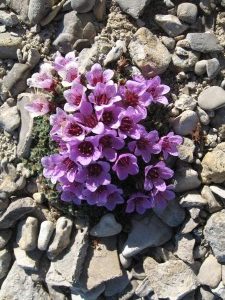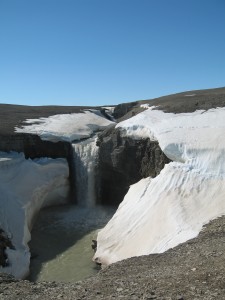Arctic Watch Lodge: In the Land of the Midnight Sun
July 31, 2014
A detailed first- hand experience story by one of our Travel Designers. A unique escape to the Arctic for an adventure filled with exotic wildlife, surreal landscapes, and extreme solitude.
Day 1
The scene 20,000 feet below me as I look out the window of the plane is of snow and frozen ice with an occasional patch of aqua blue sea water and blue sky. It is spectacular. Our charter flight, on a Dash 8 (twin propeller plane that seats 28 passengers), left out of Yellowknife, Canada, this morning, then made a stop in Gjoa Haven for fuel, and is now headed further north to Arctic Watch Lodge located on the bank of Cunningham River Inlet on Somerset Island in the high Arctic. Somerset Island is located approximately 1,800 miles north of Calgary and about 900 miles north of Yellowknife at latitude (or parallel) 74° North within the Arctic Circle.
As we landed the sun was shining, the sky was crystal clear, and the temperature was a high of 40° Fahrenheit (F). My husband and I have come here in hopes of seeing polar bears, beluga whales, Arctic foxes, muskox, and other Arctic wildlife and plants.
After disembarking, we walked a few hundred feet to the river and had to be ferried across the river in big yellow rafts to get from the landing strip to the lodge. I use the phrase “landing strip” loosely as it is merely an area of land on the scree-covered landscape that has been graded. There is no paved landing runway or even a traffic control tower, just a wind sock to aid the bush pilots in landing.
I later learned that the owners, Richard Weber and Josée Auclair, made the landing strip using a small bull dozer. To get the bull dozer from Resolute Bay on Cornwallis Island – where a cargo plane delivered it – to Arctic Watch on Somerset Island Richard and one of his friends drove the bull dozer 60 miles over the ice that is the Northwest Passage in the winter. It took them about a week to do it and they had to keep checking the ice with a corer to make sure that it was thick enough (minimum of 30 inches of ice).
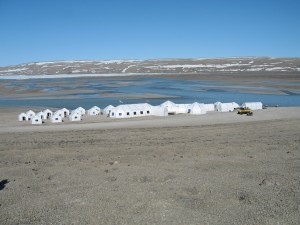
The “lodge” itself is made up of several large and small permanent white canvas tents on wooden foundations that make up the living room, dining room, shower room (yes, shared showers), kitchen, and the guest and staff rooms. I was fully aware that we would be “glamping” (glamorous camping), but it didn’t really sink in until I saw our “room”: a 12′ x 12′ tent furnished with a queen bed on a wooden frame, a small shelf unit, a small sink piped only with cold water, a small marine toilet hidden by a zippered canvas curtain for privacy, and no heater. The only heated rooms are the dining room, living room, and shower room. Luckily, we packed well!
At dinner we met the owners, their sons, the staff, and our fellow adventurers. Thus, we began our Arctic safari!
Day 2
We survived the night in the tent and didn’t freeze! Hot water bottles at our feet, hats on our heads, and many layers in between kept us very warm. Other than the unheated tents the biggest problem is that it is light 24 hours a day in the Arctic. So we also had to sleep with shirts over our eyes to block the light!
The lodge is situated on the edge of Cunningham Inlet which leads out into the Barrow Strait, part of the Northwest Passage. This morning after breakfast a group of 9 guests and our guides, Catherine and Alex, headed for Polar Bear Point – after our training session on the ATV’s (all-terrain vehicles). We will use the ATV’s as our main source of transportation while here. There are two ATV options: the green John Deere “gators” that seat 4 passengers and the red Bombardiers (aka bombas) that seat 1 or 2 people. We drove out to Polar Bear Point using both ATV types on dirt/mud trails and saw ring seals sunning on the ice as well as several flower species (i.e., Arctic poppy, mountain avens, several saxifrage, a miniature Arctic willow tree, and more) scattered about the ground. We also were able to walk out on the ice within the strait – yes, we walked on the frozen ocean, on the Northwest Passage! It was an amazing feeling.
After lunch, we headed out for a hike to see three waterfalls with guides Catherine and Laurence. The tundra is made up of very hilly terrain that is covered in scree, and is very wet due to the melting snow. It was like crossing a bog in areas. We eventually made it to the waterfalls and gorge that must have had a 100-foot drop. The scenery was amazing. Wide-open space surrounds us. No one else for miles and miles. A wonderful first day in the Arctic.
Days 3 and 4
The weather was bad these two days with rain, temperatures in the low 30’s F, and winds with gusts up to 25 miles an hour. However, after a delicious breakfast both mornings several of us headed out past Polar Bear Point on the ATV’s toward Cape Marie looking for polar bears. Just last week a female with two cubs was seen in the area while marathon runners were racing. However, after spending approximately 12 hours (6 hours per day) driving around the northern part of the island, much of the time in the rain and staring at the frozen ocean looking for polar bears and beluga whales we didn’t see any. We did see several ring seals and a variety of seagulls. Shortly after returning to camp on Day 3 we did spot several adult and baby muskox.
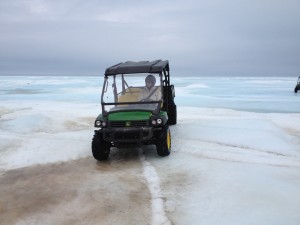
I think the most exciting thing that happened on both days was that I drove a gator with three other passengers on the Northern Passage on solid sea ice! I was told that the ice is about 4-feet deep and not to worry. However, it was still extremely nerve-wracking and exhilarating at the same time – especially when driving over cracks in the ice ranging between 12”-24” wide in places! This is definitely not something that can be done in many other places in the world, but our guides Catherine and Raph were fantastic in finding the best places to drive on the ice. One day I got one of the gators stuck in mud. Everyone found flat rocks that we used to place under the tires and then Raph used a winch to pull the gator out. Then off we went to find a bit of shelter for lunch. Finding no shelter we lunched in the rain. All part of the adventure of being in the Arctic, I am told.
As stated above, the weather these past two days has been stormy with lots of rain and very strong winds. Although sunny weather is my preferred option, this storm is desired because the rain will melt the sea ice faster than sunshine and the wind will blow the small chunks out to sea allowing the Cunningham Inlet to open up, which will then allow the beluga whales to enter the inlet as they do every summer to nurse their calves, molt, and play.
Day 5
Another day of bad weather (fog, rain, and wind) so in the morning we went for a hike to the waterfalls and after a delicious lunch some of us went river rafting and kayaking with Richard and another guide, Alex. We had to wear drysuits in case we fell in the water as the water temperature is in the high 30’s-low 40’s F. The view of the ice with its various shades of blue was beautiful from the kayak. We also saw a ring seal today, but they are skittish animals and slip quickly into the water even if we are hundreds of feet from them.
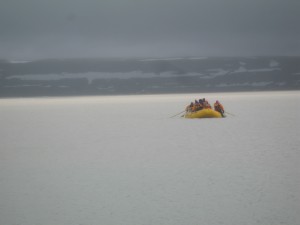
This evening we listened to a lecture given by Dr. Valeria Vergara, a beluga whale scientist/researcher from the Vancouver Aquarium. She is here, living in an unheated, leaking yurt about 1 mile from camp for 6 weeks to study the communication between beluga whale mothers and their calves.
Day 6
The weather was a bit foggy today with some wind, but no rain. The ice still has not broken up enough for the beluga whales to use the inlet. Since there are no beluga whales to watch we rafted across the river and went for a hike up to the ridge above Gull Canyon with guides Catherine and Laurans. The hike was wonderful and the view from the ridge spectacular. Black-legged kittiwakes (a gull) were nesting on the crags within the canyon with a few fledglings on the nests. We also saw muskox, an Arctic hare (cute!), eider ducks, long-tailed skua, as well a rough-legged hawk circling overhead.
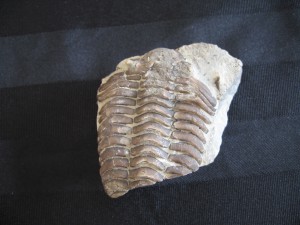
Toward the end of our hike we wandered down a shale and rock covered hill and I found a large fossilized trilobite! A trilobite was a small marine animal from the Paleozoic era (360-435 million years old). Exciting!
In addition, I saw two Arctic woolly bear moth caterpillars today. If any animal gets the prize for perseverance it is this caterpillar. It has an anti-freeze of sorts in its body and freezes every winter then thaws in the summer to feed on Arctic willow, then freezes again in the winter with this cycle continuing for anywhere from 7 to 14 years before it has eaten enough to morph into a moth to mate and die. What a life!
This evening we listened to a lecture given by Richard about his many trips over the past 20 years to the North Pole. I must say that cross-country skiing over rough terrain and floating ice slabs as well as swimming in cold water when the ice starts to melt for 120 days or so with a sled packed with about 360 pounds of supplies/gear in temperatures as low as -50° F does not appeal to me! He said they would eat over 7,000 calories a day and still lose weight. They gauged the temperature as such: it is -31° F when they could gnaw on a stick of butter; it is -40° F when a stick of butter snaps cleanly in two pieces; and it is -58° F when a stick of butter shatters like glass. Adventurers wanting to get to the North Pole eat a lot of butter and macadamia nuts on the excursions due to the high fat and calorie content.
Day 7
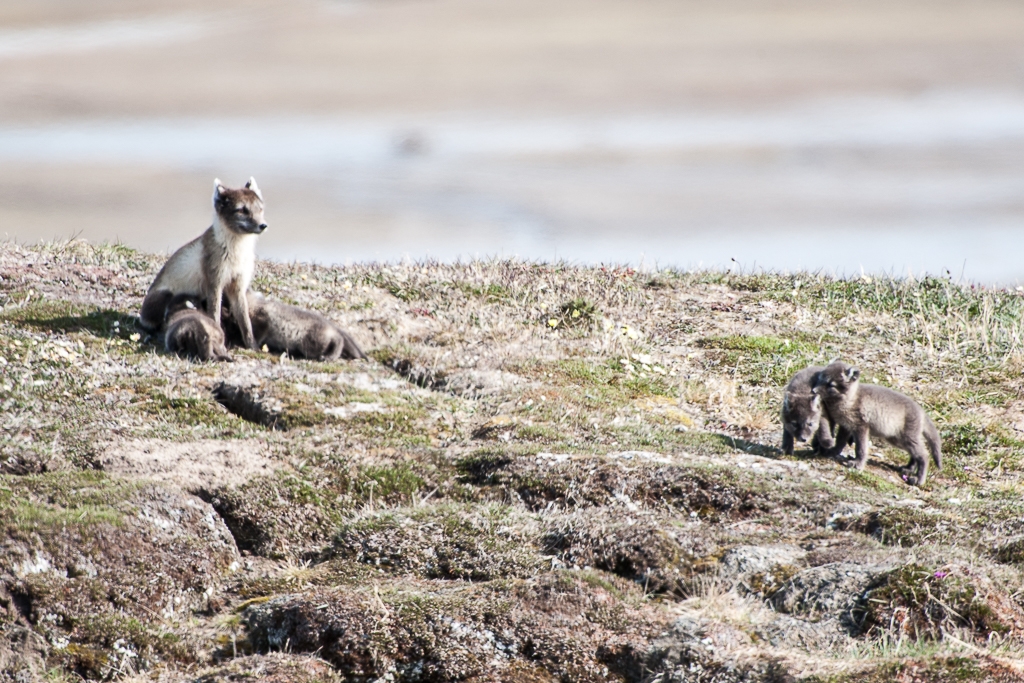
More high wind and cloudy skies today, but again this is good news as the wind continues to push the ice out of the inlet. This is definitely not the trip we were anticipating as we expected that the beluga whales would be here by now. Supposedly, the weather is about two to three weeks behind schedule so the ice has not melted enough yet to allow the beluga whales to enter the inlet. To keep us busy today there were three options for outings. My husband and I chose to go sit near a known Arctic fox den in hopes of seeing this elusive animal. Others had gone several times during the past week and had only seen an adult female once for a brief time. At this particular den 13 cubs and 2 adult females were observed about 2 weeks ago. To get to the den, a group of four guests and our guide, Alex, rafted across the river, drove a few miles in a UNIMOG (a heavy duty military-like vehicle built by the Swiss in 1962), then hiked about a quarter of a mile to the den. Luck was with us! As we approached the den we could see three or four little fox cubs playing outside on the top of the mound. We immediately dropped to the ground and watched. Every few minutes we would move forward a few feet and finally settled in about 100 feet from the den. Eventually, the little cubs got tired and went inside the den to rest. About an hour later someone spotted a fox trotting across the tundra. It was the adult female coming to check in on the cubs. As she approached the den five cubs popped out of the various entrances to the den and bombarded the female. Some started nursing and others were playing with each other. After about 15 minutes, the female took off again and the cubs played for a while before going back inside the den. We sat in place for about 4 more hours in the freezing wind in hopes of seeing the foxes with no more luck. But what a wonderful day it was!
Day 8
Arctic Watch Lodge has only week-long stays due to the distance from Yellowknife and the difficulty getting in and out of the area. As such, all flights arriving to and departing from Arctic Watch Lodge are only on Fridays – today. This day is called “turnover day” by the staff. One group of guests arrive as the other group of guests departs for home. Today, however, the clouds are very low, the wind is rather high, and it is pouring rain. Therefore, the plane cannot land so the guests who were supposed to fly in today must spend another night in Yellowknife and the guests who were supposed to leave today cannot. When booking the trip all guests were encouraged to add an extra day or two in Yellowknife prior to flying home for this very reason. The guests who are stuck at Arctic Watch are not charged for the extra night at the lodge. On the other side, the guests who have to stay another night in Yellowknife and miss a night at the lodge are not reimbursed for the night missed at the lodge. This is the perfect reason to get travel insurance for trips – especially to Arctic Watch Lodge!
Since the weather was so bad today no activities were planned. As such, guests hung out in the huge living room, which is heated, and played ping pong, worked on puzzles, chatted, read, and changed their hotel and plane reservations. Since my husband and I are staying for two weeks we are not affected and so I opted for a hike near camp with four other guests.
Day 9

The morning excursion consisted of driving out to the Badlands located south of the lodge in the ATV’s. It was rough driving given the mud. About 45 minutes out from the camp one of the gators got stuck in the mud up to the axle. For some reason our guides had not packed shovels or planks as they had done previously. So we radioed for help. While waiting for assistance to arrive we explored the mud flats and took photos. Getting stuck in the mud at Arctic Watch is par for the course.
After lunch and as the guests leaving the lodge one day late headed out to the air strip, Valeria (the beluga whale researcher), Nansen (son of the owners), my husband, and I headed out to Polar Bear Point. Valeria wanted to put the hydrophone in the water to see if she could hear any beluga whales. Once at the point and on the ice we unloaded the equipment and Valeria hooked it up to the computer with special software. However, the computer and hydrophone weren’t communicating so we packed up the equipment and returned to the lodge to meet the new group of people and dine on delicious food.
Day 10
Off to Polar Bear Point again this morning to check on the ice and see if any beluga whales are out in the Northwest Passage. The Passage is clear of ice and a part of the inlet is now open so we hope that the beluga whales will show up soon! The clock is ticking for us, but no beluga whales today and no polar bears either.
After a hearty lunch of tomato basil soup, sandwiches, and gigantic chocolate chips cookies, four of us and Nansen rafted across the river then hopped on the bombas for a 4-hour excursion to Muskox Ridge. We drove over hill and dale and across creeks and rivers on our ATV’s – my husband riding behind me hanging onto his camera gear with one hand and the ATV with his other hand as I drove – bouncing along over the rough terrain. He said my driving of the ATV was perfect, but that it was one of the worst rides he’d ever had! How is that even possible? During our excursion we saw about 20 muskoxen in the meadows, a snowy owl off in the distance, and plovers along the edges of the creeks. We also hiked down into a bog just to see what we could see and stopped by the fox den to see if any cubs were out playing. No luck at the fox den so off we went looking for other animals and enjoying the amazing but barren Arctic scenery.
Day 11
A full day is in store for 10 guests and 2 guides today. We have decided that since there are no beluga whales in the Cunningham Inlet and no chance of them showing up here in the near future that we would head out to Cape Anne to see a Thule site. Cape Anne is located approximately 40 kilometers and a 2.5- to 3-hour ATV ride from camp. Thule are Inuit ancestors from about 1100-1400 A.D. and the archaeological site is a circle of flat rocks wedged into the ground to create a base with ½ of the floor covered with flat rocks – the sleeping areas – and the other ½ left as ground that was used as the cooking area. So, we all piled onto the ATV’s (gators and bombas) and headed out around 10 am. Sadly, my husband was not feeling well today and opted not to join us.
It is rough and slow going on the ATV’s as there is mud, snow, ice, and rocks/shale covering the very hilly terrain. We stop at various look-out points to check the sea ice for polar bears and the sea for belugas. At each stop we see nothing so move on. Our lunch spot is located at a point where the land protrudes out into the sea as a small peninsula and is where the strong Northwest Passage currents push the floating ice onto the shore creating strange-looking hills and piles of ice about 20-30 feet in height called pressure ridges. It is beautiful and the colors of blue are wide-ranging.
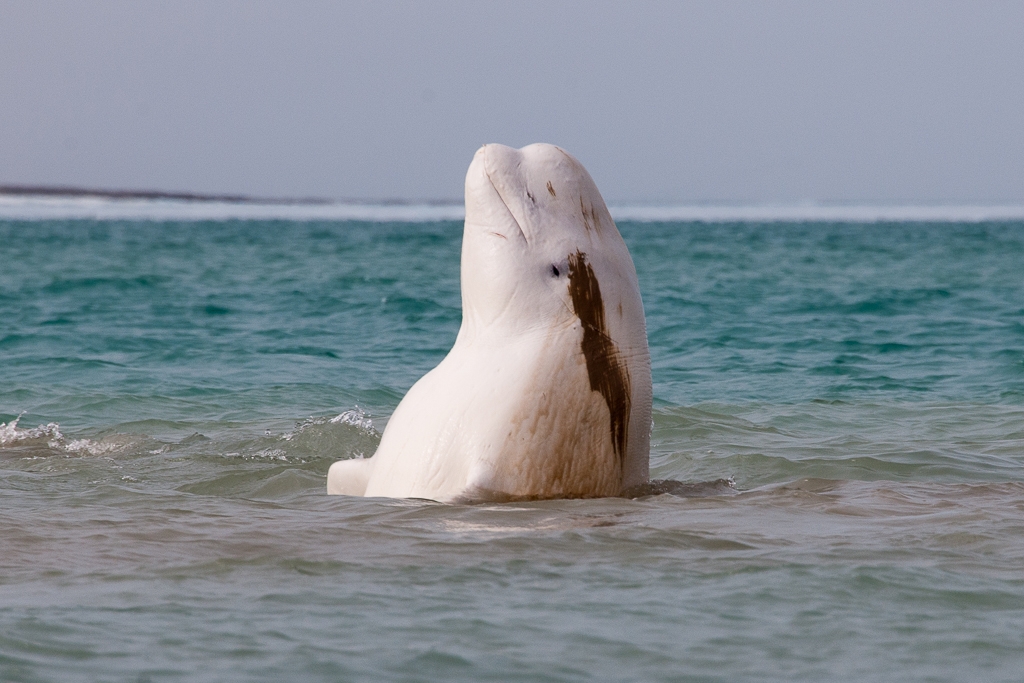
Finally, we start the last leg of the trip toward the Thule site. I am in the last of four vehicles in the back seat looking out to sea. I notice several white things bobbing at the surface of the ocean. At first I think they are just more smallish ice chunks floating along in the current. Then I realize they are going under and popping back up again. I yelled out to the guest who was driving to stop, I hopped out of the ATV, and ran for the shoreline. BELUGAS!!!! Bobbing, white and grey beluga whales. Eventually, the other ATV drivers realized that we had stopped and came back to check on us thinking we had gotten stuck in the mud. Once everyone realized that the reason we stopped was because we spotted whales they all grabbed their cameras and we headed for the Cape Anne River inlet. There were about 85 belugas (as best that we could count) doing their social behaviors of rubbing on the shallow sand to help them molt, spy-hopping, waving tails high into the air, doing the banana (head and tail arched up in the air at the same time), playing, splashing, and communicating. Beluga whales are called the “canaries of the sea” since they click, squeal, chirp, whistle, and make noises that sound like a horse, a cow, a chicken, a foghorn, and like they are “blowing raspberries.” They are just plain noisy whales. They make hundreds of different sounds when communicating with other belugas. We spent about 90 minutes watching them and taking photos. It was so exciting and fantastic!! I have never seen anything like this before. But it also made for a very long 10-hour day trip. All of us were freezing by the time we reached camp – but it was so worth it!!
Valeria, the beluga whale scientist, and two others went out to Cape Anne Point at 9 pm to put the hydrophone in the water to see what calls the belugas were making and to get a better count (remember it’s light 24 hours a day). On the way they got stuck in the mud and it took them 2 hours to dig themselves free! Once they made it to Cape Anne they saw only a few belugas migrating several hundred feet from shore in the Northwest Passage and none were socializing in the shallows of the inlet as they had been doing earlier in the day. They also saw several narwhal whales migrating.
Day 12
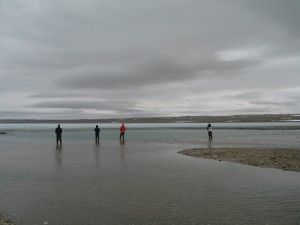
All the guests are very eager to head back out to Cape Anne River inlet in hopes of seeing beluga whales. However, only 9 people can go due to space restrictions on the ATV’s and no one who was out there yesterday is allowed to go out to Cape Anne today, which is understandable. Therefore, my husband, who was ill yesterday but suddenly feeling better today (the arrival of belugas has a way of doing that to a person), headed northwest to Cape Anne River inlet. Meanwhile, 5 other guests and I headed southeast to Lake Inukshuk to fish for Arctic char, a kind of salmon. The ride to Lake Inukshuk took us about 3 hours on the ATV’s. We stopped at various locations along the way to watch the muskoxen, observe the fox den in hopes of observing frolicking fox cubs, and to check out a bowhead whale jawbone protruding out of the ground. The open, far-reaching scenery is incredible consisting of scree-covered slopes in various shades of brown, meadows and bogs in a variety of green and yellow hues, and crystal-clear water flowing in the streams with small groups of muskox foraging on the landscape. There is absolutely nothing else on the
landscape except the lodge and no man-made sounds except our voices and vehicles. The vegetation is sparse and that which does exist is very low-growing. The grasses rarely exceed 5 to 6 inches in height. The Arctic willow tree grows prostrate on the ground and rarely reaches more than 2 inches in height. A 2-inch Arctic willow tree is about 200 years old because the growing period is so short (only about 6-8 weeks).
Lake Inukshuk was still frozen except about 30 feet around the edges. After lunch everyone went fishing for char at the river mouth. Within 10 minutes the first fish was caught. We kept the first three fish, each about 24 inches long, to take back to camp for sushi, and the remaining 13 fish caught over the next two hours were released. Once everyone was done fishing we all piled back onto the ATV’s and returned to the camp. It was a wonderful day with great company.
Day 13
This morning all guests wanted to head out to Cape Anne in hopes of seeing the belugas. As before, any 9 guests who had not been out to Cape Anne in the last 2 days were first in line to go today. However, 3 spots were open for guests who had previously been. My husband and I immediately signed up. We headed out after dressing for the cold and wind: two pairs of socks plus muck boots, 5 layers on the lower body, 6 layers on the upper body, 2 hats, and a riding helmet! It’s seriously cold on the 2.5- to 3-hour drive.
The entire drive I am facing the sea looking for belugas. It occurs to me rather infrequently to look inland for polar bears as I am so focused on one thing – belugas! And can you even believe it – I missed the female polar bear with a cub loping along the ridge! The people in the last two ATV’s saw them as they crested a ridge, then ran along the ridge for a minute – scared of the ATV noise – and then headed back behind the ridge out of sight. The guide on the last ATV with the radio forgot he had the radio to call the lead guide. Ah! Happily though, my husband was one of the 5 guests who did see the polar bears. He was thrilled beyond belief! Of course, I have no photos of the polar bears because it happened so quickly that not one of the 5 people thought to take a photo.
The guides all carry shotguns with slugs and bird shot for each group in case polar bears are spotted and come toward the group, as they do at times. Primarily, the shotgun makes so much noise that it scares the bears and they never shoot to kill except as an absolute last resort (which has never happened in the lodge’s history). Any time we go out for a hike near the camp, but without a guide, we have to carry pepper spray. Pepper spray, in my opinion, is sort of useless because the bears would have to be quite close for the pepper spray to hit them and you can only spray it downwind in place with wind often swirling all round you, but we take it anyway.
We spent about 2 hours at the Cape Anne River inlet today and did not see any belugas. We did, however, see several narwhals migrating eastward. The ice is moving out of the Cunningham River inlet and thawing more and more each day. Conditions seem right for belugas to make their way from the Passage into the inlet. But as we stop along the way home and look with binoculars we see no belugas. A helicopter pilot is here to transfer two geologists conducting mining research. On the way back to camp they flew along the coastline and reported that they saw the belugas swimming back and forth along the northern coast of the island. They are out there in the Passage and want to get into the inlet, but the ice won’t let them.
Day 14

Today I opted out of the Cape Anne trip due to the long ATV ride. My husband, however, opted to go back out for the third day. Only 6 people wanted to go out to Cape Anne today so there was no battling for space. I opted for the kayaking/hiking option. Six guests and two guides hiked to the kayaks which were located about 1 mile away. Once at the kayaks we suited up in dry-suits, life vests, and kayak skirts. Then we set out to sea and kayaked about 45 minutes cross Cunningham River inlet. The water was smooth and aqua-colored with ice floes scattered about. Once on the other side of the inlet we hiked above Flat Rock Canyon. The crystal clear blue water rushed over the dark brown, stepped lawyers of sedimentary rock. After lunching on the tundra we kayaked back across the bay. The wind had picked up significantly and it took us a bit longer to get across the inlet.
My husband and the guests who headed out to Cape Anne today saw belugas in the distance migrating, but none doing their socializing behavior as seen several days ago.
It’s our last night here at Arctic Watch and we are feeling both happy and sad to be leaving. I personally am looking forward to getting back to civilization for a proper shower with consistently hot water, sunshine, and dark evenings! But we are sad to leave since we didn’t really have the awesome experience of observing belugas as we had expected. Oh well, that’s wildlife. You just have to be patient and get the timing right as wild animals show up when they want to show up.
After a rather late dinner my husband and I headed to bed. It was pouring rain – harder than we have seen over the last 2 weeks – and really cold. In addition, the generator is turned off each night at 10 pm so there is no longer any heat in the common areas so there is no reason to stay up. Around 10:40 pm we started hearing yelling and shouting in the camp. The wind was gusting beyond belief, which causes the tents to flap and makes a ruckus, and there is thunder in the distance. We can’t understand the words being shouted, but we assume that someone’s tent might be leaking or something. We figured staff would sort it out quickly. But after 5 or more minutes of yelling by many people now we figure we should see what was going on. I put my coat on and go outside. A guest runs by yelling “the belugas have arrived! They are out in the inlet!!” What?!? I run back to the tent and excitedly tell my husband that belugas have been spotted in the bay. We dress in our outdoor gear as quickly as possible, grab a camera, and start running for a high point on the shoreline. Several people are already there pointing excitedly at the water. About 50 belugas made it into the inlet and are socializing: spy hopping, tail bobbing, rubbing their bodies on the sand and playing. Amazingly, the pouring rain stopped, the sky cleared, and the thunder and lightning continued. We stayed until 1 am watching the whales and the sky show, all of us ‘oohing’ and ‘aahing’ at each spy hop and lightening flash like we were at a fireworks show. Such a very special evening!
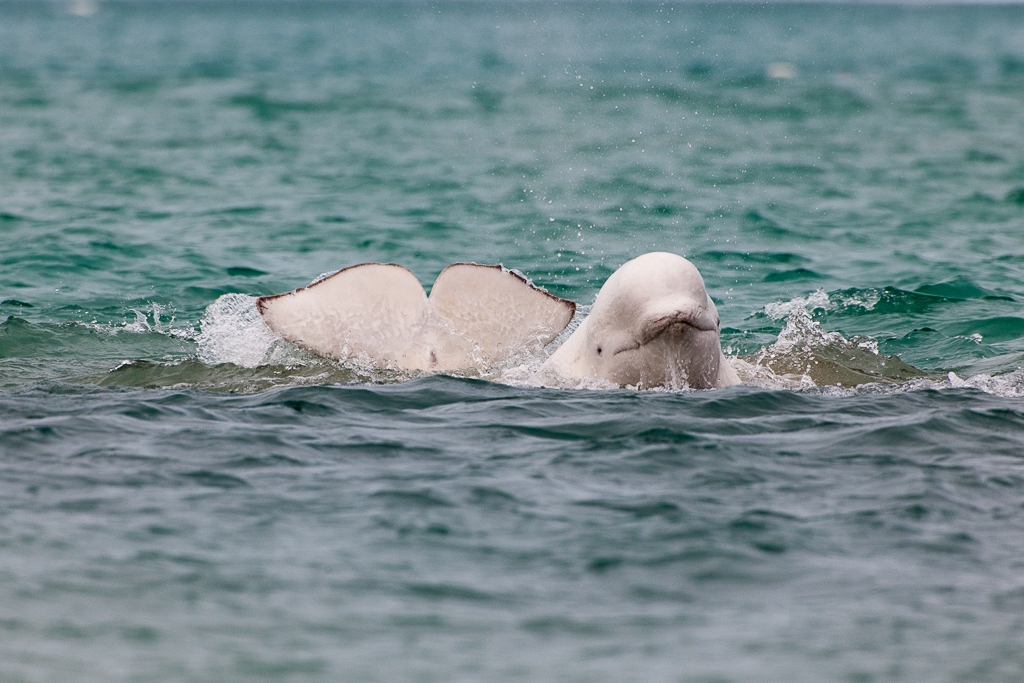
Day 15
Today is turnover day (Friday). After breakfast we packed up all our clothes and things and prepared to leave later this afternoon on the charter flight back to Yellowknife. It was clear, sunny, and beautiful outside. I commented to a staff person that the temperature was up today hovering around 45° F. His response was, “great, let’s get the bathing suits out!”
Once packed we headed out to spend the morning watching whales. Woohoo! We rafted across the river, loaded up in the UNIMOG to drive out on a sand spit, and then walked 5 minutes to the water’s edge. The whales were within 30-50 feet of us moving like inch worms along the muddy river bed exfoliating/molting in the shallow waters, spy-hopping, and communicating with each other.
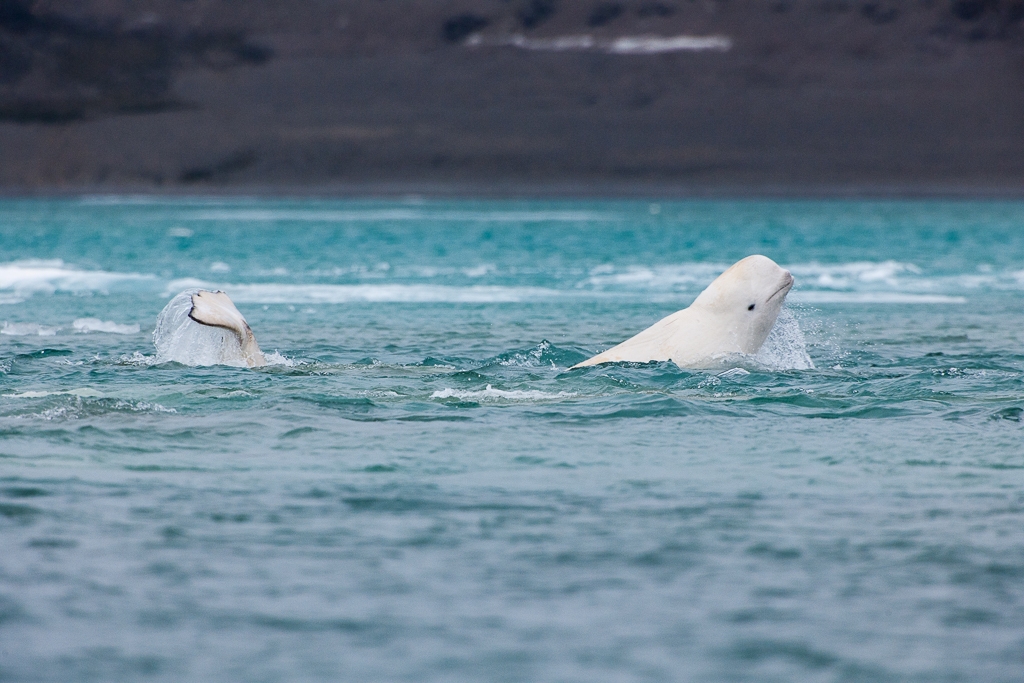
As we watched the whales do their thing we began noticing a heavy fog roll into the valley. If it gets worse the charter flight won’t be able to land this afternoon, which means that we won’t be able to leave. We stayed out on the sand spit until 12:30 pm then headed back for lunch. The fog continued to thicken. Once back at the camp we were told that the charter had been canceled and that we get to stay another night at Arctic Watch – just like the folks last week. This is both bad and good. It is bad because everyone has hotel and plane reservations to change so the air is thick with tension and anxiety. On the other hand, it gives us more time to watch the whales!
Day 16
It is still foggy this morning, but the fog is supposed to lift at 12 pm. As such, the charter flight company has been called and told to bring the new guests out to Arctic Watch and to pick up the current guests to be returned to Yellowknife. The plane is scheduled to arrive at 5pm today. Similar to yesterday, we packed our bags (again) after breakfast then headed out to the inlet to watch the belugas – another fantastic morning watching belugas in the mist. The scientist had her hydrophone in the water and we were able to listen to the whales communicating under water via a speaker plugged into the laptop. Incredible!
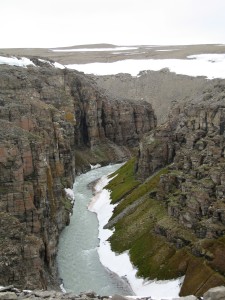
Around 1 pm the guests headed back to the camp for lunch just as the fog was lifting. We are going home today. After lunch, several guests who wanted to go back out to the sand spit to watch the whales (myself included) were loading up in the UNIMOG just as Richard got a satellite phone call. His face looked grim as we waited for him and we noticed the fog was returning to the valley. As Richard hung up the phone we all knew that we would not be returning to Yellowknife this evening. It’s too foggy here and at three other crucial locations along the route that the pilots have to use for emergency landings and refueling. Up here in the Arctic the bush pilots typically have to land using visual flight rules (no instrument landings) as there are few air traffic control towers – just a wind sock! So we get off the UNIMOG and go inside to rearrange our hotel and plane reservations for a second day in a row. In the 16 years of the Weber Family running this lodge this is only the second time a two-day delay occurred. One-day delays are rather common, however.
The warm weather put swimming into the minds of the staff. After dinner, the guests were given the opportunity to go for a “polar bear swim.” Sign me up!!! I did this in Antarctica 5 years ago so must do it in the Arctic.
The fresh river water that we will swim in is near 40° F, warm compared to the nearby ocean water that is approximately 30° F! Wearing only bathing suits we donned life vests. Each participant then dove head first off a rock into a big pool in the river to a chorus of the cheering crowd. Hitting the water literally sucked the breath out of me. WOW! It’s cold!!!! I am sure the look on my face was of shock and exhilaration! However, my husband says that the look on my face was of mild relief that it wasn’t as cold as I expected. It really was not as bad as I expected, but it was still very cold. We each swam to shore as fast as possible and climbed onto dry land with towels being tossed to us. It was definitely warmer out of the water. Of the 35 or so people at the lodge, including staff and guests, only 8 people went for a dip: 4 guests (all of whom were women!) and 4 staff (3 men and 1 woman). A bonding experience like none other.
Day 17
It’s beginning to feel like the movie “Groundhog Day.” We eat breakfast, are told to pack up because the plane is coming, then bundle up in 5 layers of clothes, and head out to the sand spit to watch the belugas.
Apparently, because the belugas coming to Cunningham River Inlet are hunted by the local First Nation people, they are very skittish. We are told to keep our voices low, not to walk along the water’s edge, and be careful of splashing water if we need to cross from one sand spit to another away from the inlet. The owners know this from first-hand experience. However, some guests just don’t listen or don’t think it applies to them. After about an hour of watching a family group of about 30 whales splashing, playing, and spy-hopping within 50 feet to the east of where most of us are standing, a guest decides to cross from one sand spit to another through almost knee-high water to get a closer view. She does not realize the water is so high and as she wades across she is splashing and the cold water goes over her boot soaking her feet. She screams at the shock of the cold water on her feet, but keeps walking out to the spit. Within seconds we hear a foghorn sound from a beluga, then a second foghorn sound in response. Suddenly, this family group, adults and juveniles, is speedily swimming away from us in tight formation at the surface, the foghorn sounding repeatedly. They swam at least 300 feet west of us over the course of a few minutes. One bull at the lead, one bull at the back, and one on each side, escorting the family group to safety and away from a noisy, splashing human. It was fascinating to watch this behavior, but disappointing as well – now they are too far away to photograph and enjoy.
Eventually, it is time to go back to camp to prepare for our true departure! The chartered plane is on its way with new guests and fresh supplies. We are thrilled to be going home two days later than expected.
As we ferry in rafts across the river and walk to the landing strip spirits are high. After nine days together we are all best friends and have exchanged email addresses and the promise to send photos and to call if we are in visiting a city where someone lives. Finally, the plane lands and the new guests disembark. We cheer them on and wish them a great week.
Once on the plane, we settle in for our 5-hour flight that includes two refueling stops, one at Resolute Bay and one at Cambridge Bay, due to high winds. Finally, we arrive in Yellowknife. Most of us are staying at the main hotel in town – The Explorer Inn. After a quick shower 16 of the 24 guests reconvene at Boston Pizza, the only restaurant open at 10 pm on a Sunday night in Yellowknife, Canada.
In the morning, with the crowd thinning to about 10 people, we meet in the hotel cafe for breakfast. One or two people at a time gradually get up to check out and head for the airport or go for a walk. My husband and I are on the same flight as 7 others and we sit and chat at the airport and on the plane. In the Edmonton airport, as we disembark then split off for various flights to other destinations there are more promises to call “if you are in Toronto,” “call if you are in London,” and “call if you are in San Diego.” The joy of traveling to far-off places not only includes seeing scenery like nothing you have even seen before or observing animals and their behaviors you have never observed before, but also meeting and connecting with like-minded travelers from across the globe who you wish were your neighbors.

 +1 800 554 9059
+1 800 554 9059